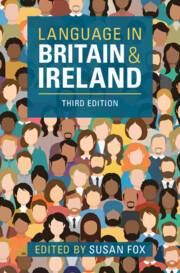Book contents
- Language in Britain and Ireland
- Language in Britain and Ireland
- Copyright page
- Contents
- Figures
- Tables
- Contributors
- Acknowledgements
- Map of Britain and Ireland
- Introduction
- Part I English
- Part II Multilingualism in Britain and Ireland: The Celtic Languages
- Part III Multilingualism in Britain and Ireland: Minority Languages
- 15 Channel Islands French
- 16 South Asian Languages
- 17 Chinese
- 18 Yiddish
- 19 European Immigrant Languages
- 20 Sign Languages in Britain and Ireland
- Part IV Multilingualism: The Development of Urban Contact Varieties
- Part V Applied Sociolinguistic Issues
- Index
- References
16 - South Asian Languages
from Part III - Multilingualism in Britain and Ireland: Minority Languages
Published online by Cambridge University Press: 17 October 2024
- Language in Britain and Ireland
- Language in Britain and Ireland
- Copyright page
- Contents
- Figures
- Tables
- Contributors
- Acknowledgements
- Map of Britain and Ireland
- Introduction
- Part I English
- Part II Multilingualism in Britain and Ireland: The Celtic Languages
- Part III Multilingualism in Britain and Ireland: Minority Languages
- 15 Channel Islands French
- 16 South Asian Languages
- 17 Chinese
- 18 Yiddish
- 19 European Immigrant Languages
- 20 Sign Languages in Britain and Ireland
- Part IV Multilingualism: The Development of Urban Contact Varieties
- Part V Applied Sociolinguistic Issues
- Index
- References
Summary
This chapter reviews the history, culture and politics of South Asian languages in the UK. South Asian migration to the UK dates back to the British colonial period. It expanded in the twentieth century, first with British Indian participation in the two World Wars and then with post-war British policies that initially encouraged South Asian immigration for low-skilled labour. South Asian communities in Britain share some characteristics but differ markedly in other respects. Overall, sustained migration, relatively large settlements, and a reduction in the early explicit hostility to migrants has meant that South Asian speech communities have tended to maintain their languages, though with inroads by English in each successive generation. South Asian languages initially struggled to be included in school curricula and university provision. Some languages, such as Urdu and Arabic, have wider religious or cultural appeal and see much higher uptake through education than other South Asian languages, even languages with more native speakers. Almost no research has been conducted on structural change within South Asian heritage languages, a rich area for future research on language contact and generational change.
Keywords
- Type
- Chapter
- Information
- Language in Britain and Ireland , pp. 386 - 401Publisher: Cambridge University PressPrint publication year: 2024

